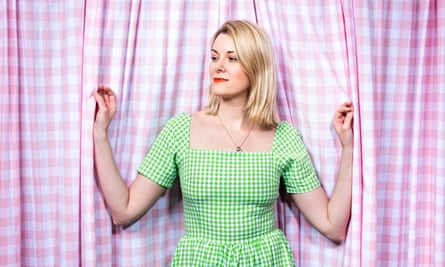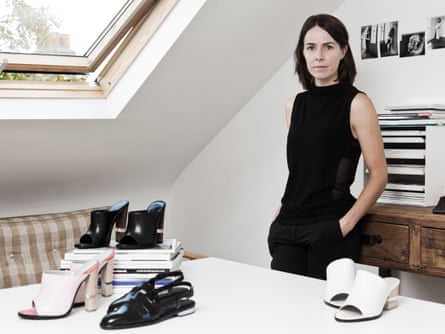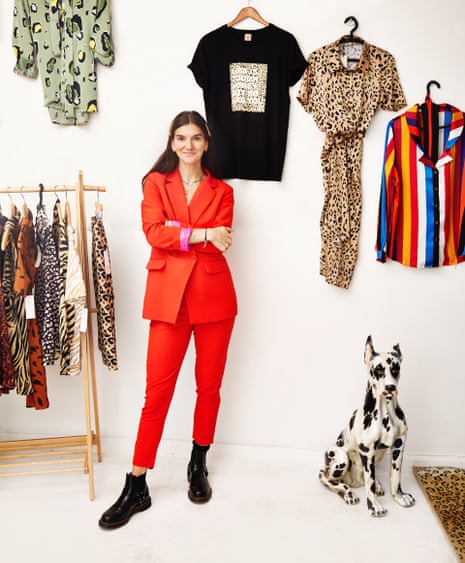We’ve all bought them at some time or another: the perfect pair of shoes. Stylish, comfortable – the kind you wear with everything until they fall apart, and you have to start scouring the internet for a replacement.
But recently you might have noticed that the way you find a replacement has changed. Not long after you begin your search, a pair of similar shoes appears, as a sponsored post, on your Instagram feed. They’re there one day, and then the next. You’ll likely end up seeing them countless times, though never in the flesh. The brand to which they belong may not even have a physical store – but its Instagram presence is such that you peruse its wares with the kind of frequency you only usually afford your local corner shop.
Gradually, the account becomes somewhere you regularly stop, just to see what’s new. You start looking at all the other items on offer: past that original pair of shoes, to mules, slingbacks, sandals.
As prospects for the UK’s high street continue to look grim, many fashion outlets are taking their business not just online but specifically to Instagram. Although primarily a social media platform, Instagram specialises in all things visual. And, unlike most online shopping sites, it has become a place for customers to browse, covet and discover. Brands, meanwhile, are cashing in on the opportunity to sell not just their products, but an entire concept.
Dear Frances is one of a growing number of brands that might be considered “Instagram famous”. You won’t have seen it on the high street but, one way or another, it may have become a regular feature on your feed. While platforms such as Asos offer a much larger and more easily searchable catalogue of clothes, their items are invariably photographed in a studio, against a white background. Instagram brands, on the other hand, specialise in showcasing their wares “in the wild”, or within a stylised set-up that fits their overarching vision of how potential customers might aspire to dress. It offers the opportunity for brands to convey not just a single “lewk”, but a whole moodboard to Insta-fashion fans.

“Instagram is more about sharing a mood or an inspiration,” says Dear Frances’s designer Jane Frances. “It’s a natural place to attract those who share your aesthetic or those who are inspired by the lifestyle of your brand.”
The appeal of shopping brands that are recognisable only “from Instagram” lies somewhere between the thrill of unearthing hidden gems, supporting small or independent businesses, and being very much “in the know”. It’s exactly what is missing from a trip to the local shopping centre.
“Spotting something on Insta is the modern equivalent of a great recommendation from a friend,” says Grazia’s fashion news and features editor, Laura Antonia Jordan. “It’s accessible. Aspirational but attainable – that’s the magic combination!”
I cannot claim to understand the algorithms that allow for products and brands to follow one around the internet, cropping up in banner ads and sponsored posts. However, there is a reason why so-called “Instagram brands” are gaining a cult following in fashion. Given how much time many of us spend using the app – over half an hour per day for millennials – it’s not surprising that it has become a source of sartorial inspiration, and the place where trends take flight. The majority of Instagram fashion brands skew towards womenswear, though some, such as Need and shoe brand Veja, cater for men, too. That has led to significant results: a third of all Instagram users have now bought an item of clothing they saw on the social network.
We tend to follow the people and brands with which we feel most closely aligned, images to which we at once aspire and relate. It’s the reason why my own feed is a mix of roll-top baths, weird food, girls with great makeup, unsettling artwork and ex-reality TV stars – and, of course, niche clothing labels. Unlike Facebook, Instagram is a curated feed of not just our friends’ lives, but also our own. It’s the images we want to look at on our commute, on our lunch break and last thing at night. Of course fashion wants a piece of the pie.
“I started the Instagram account before I even launched the website,” says Lisa Bühler, founder of fashion brand aggregator Lisa Says Gah (currently 195k followers). The site stocks a number of designers, some of which might be considered Instagram famous in their own right, as well as in-house brands – all thoughtfully curated towards a particular aesthetic.

“I began with inspiration posts, like charming interiors and retro films, just to get an idea of the look I was going for. Once we started bringing in products we also posted those, but not in a traditional retail way – not in a studio, just on the street in front of the office and on employees and designers. It had always had an authentic behind-the-scenes feel.”
Ganni, one of the brands stocked by Lisa Says Gah, has several stores across Denmark, Norway and Sweden, but in the UK their “Scandi 2.0 sense of style” is a hit on Instagram. It has amassed 561k followers.
“I think Instagram has become the best discovery tool for customers in fashion,” says Ditte Reffstrup, creative director at Ganni. “Maybe you stumble across a brand while scrolling, or you want to check out a brand someone tells you about – the first thing you do is go straight to its Instagram profile, not its site.”
This has become particularly significant since March last year, when Instagram rolled out their “shoppable posts” feature, allowing brands to tag items available for purchase and customers to shop in-app. Brands don’t even need their own website to set up shoppable posts with “product stickers” – just a Facebook catalogue.
Arguably, such convenience also feeds the problem of throwaway fashion. In addition, it has prompted the rise of what Jordan refers to as “the Insta-bait buy” – clothes that are designed to stand out not just in a crowd, but on an increasingly crowded feed. Inevitably, these can become clothes that are worn fleetingly, with new Insta-trends sparking new purchases on a regular basis.
Instagram also pedalled some of this year’s less practical trends. Straw bags and see-through clothing both made Vogue’s list of “the biggest, most influential trends… on Instagram in 2018”, but neither appeared quite so prevalent in real life (particularly in chillier climes). Yet if this is evidence of how “doing it for the ’gram” has seeped into fashion, trends such as the prairie dress and the sparkly barrette surely go some way to redressing that balance.
A prime example of a label which has basked in Insta-notoriety over the past couple of years is Réalisation Par (464k followers), the brand behind what i-D described as “the internet’s favourite dress”. The dress in question, the Alexandra, was the long-sleeved ruffle mini, sported by everyone from Alexa Chung to Bella Hadid. This summer, it was “the Naomi” – Réalisation Par’s leopard-print slip skirt – that flooded not only their own Instagram profile, but everyone else’s too, and sparked copycat versions up and down the high street.
On the one hand, the Insta-ubiquity of the leopard print skirt was testament to the many ways in which it could be styled: it looked just as good teamed with trainers and a baggy cream T-shirt as worn with strappy sandals and a crisp oversized shirt or a black roll-neck and blazer jacket. The brand has made the most of its Insta-acclaim by featuring a “shop Instagram” section, as well as simply a “shop” section on its website.
Never Fully Dressed (304k followers), which describes its single store as “a nice front of house” for its majority online sales, has taken this type of styling inspiration into its own hands, creating bespoke videos that prove particularly popular on Instagram. Demonstrating how to wear a garment six different ways, or for more than just one season, as Never Fully Dressed does is, of course, a valuable antidote to fast fashion – but can smaller brands afford not to push sales?
“If someone’s spent their hard-earned cash with you, you want them to get their full wear,” says Lucy Anne Tighe, founder and creative director at Never Fully Dressed. “I’d rather keep you as a customer and tell you how to keep wearing what you’ve already got from us.”
“Instagram lets us see how an outfit goes together rather than seeing separate items on a rail,” says fashion psychologist Carolyn Mair. “For some people, this is very helpful, even if the outfit looks very different on them. But the beauty of Instagram is that the images we see are not all professional photoshoots. Many of the influencers are ‘ordinary’ people. This means the fashion imagery is far more representative than we have seen in traditional fashion imagery.”
This may also be part of Never Fully Dressed’s appeal; Tighe ropes in friends and staff to model the clothes for posts and stories. Often, the brand’s styling videos come about as a direct result of customer feedback, and using Instagram as a platform for engaging with shoppers is certainly part of what has elevated select brands to cult status.
“There’s no better way to talk to future and current customers,” says Sarah Staudinger, cofounder of Instagram favourite Staud, which looks to offer “accessibly priced clothes... that forgo trend for timelessness”. That said, celebrities and influencers remain a big part of creating “must-have” items. Staud’s signature Shirley bag was quickly dubbed summer’s “It-bag” and sold out, having been posted by Instagram’s head of fashion partnerships, Eva Chen. “We showcase the brand through our own content, through influencers posting and tagging us which we repost in our stories, and through everyday customers posting their purchases,” says Staudinger.
A case in point is eco-friendly trainer brand Veja, which reached the number one spot in Lyst’s ranking of “the cult Insta brands we all wanted to wear” in 2018. The brand has seen sales increase 113% year on year – and sold out in white after Meghan, Duchess of Sussex, wore a pair on her royal tour in Australia. Ganni, meanwhile, made number five – partly thanks to the proliferation of #gannigirls on Instagram.
“My favourite Insta brand is Ganni,” says Jordan. “I met [founders] Ditte and Nicolaj and they told me that although it’s a ‘moment’ when, say, Beyoncé wears something, it doesn’t translate into sales in the same way that it does getting it on the right kind of influencer who doesn’t even need to have a big following.”
If Instagram has levelled the playing field in terms of the people who might become trendsetters, has it done the same for small, unknown brands looking to make an impact with a competitive industry?
“Definitely,” says Reffstrup. “Instagram has really democratised fashion. If you have a strong visual, creative eye that can capture what you stand for, it’s such an incredible platform.”

Comments (…)
Sign in or create your Guardian account to join the discussion